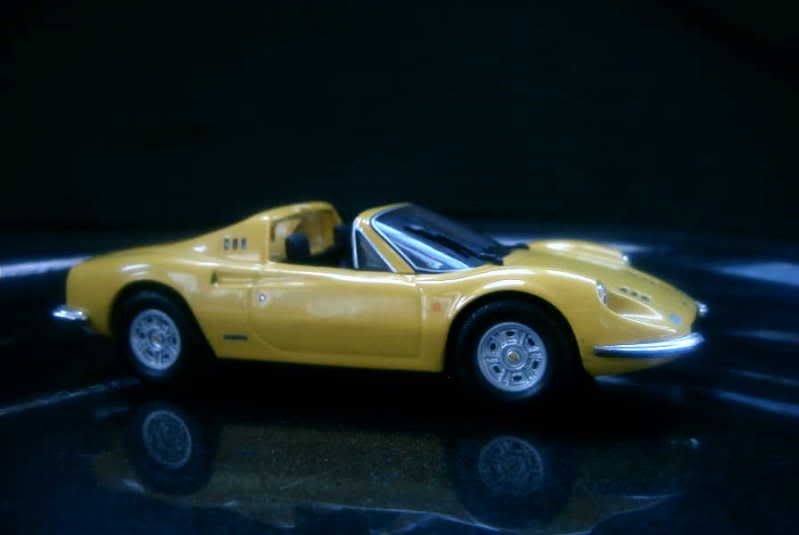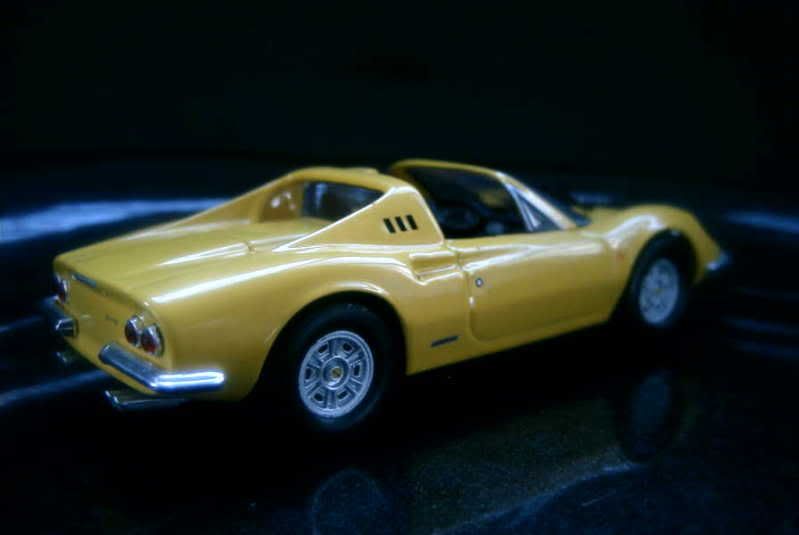A little history
The company from Maranello decided early on to reserve the “Ferrari” name to V12 cars exclusively. When a V6 was designed, it was named “Dino”, honouring the memory of Enzo Ferrari’s late son Alfredo, whose nickname was Dino and to whom is credited the idea of this very first V6.
For several years Dinos were racing cars, but the idea of building a cheaper road-going GT powered by a similar V6 was tempting enough. Engineer Vittorio Jano was its main proponent, but he insisted on a central engine – Enzo stubbornly refused. Jano’s resolve finally won over Ferrari’s obduracy.
The first Dino would be the 206 GT, introduced at Turin in 1967. Aurelio Lampredi had converted the V6 racing engine for road use; it sat in a central, transversal position on the chassis. Though officially rated at 180 hp, its actual output should have been closer to 160 hp. With all-independent suspension and disk brakes on all four wheels, the handling promised much, but styling wasn’t neglected. Pininfarina signed a perfectly balanced design, reminiscent of the racing Ferraris of the time, bulged over the wheels, extended up front by a long protruding nose flanked by headlights set deep in the wings, and pierced by side air intakes that were so appreciated that they would be carried over several generations of Ferraris. Entirely made of aluminium, the body was built at Scaglietti’s, a long-time partner of Ferrari. Though a Ferrari design, the Dino V6 engine wouldn’t be made in Maranello either. After an agreement had been signed allowing its use in the Fiat Dino car, the Italian giant took over its construction, and sent back to Ferrari the blocks needed for the Dino 206.
In this initial form, the junior Ferrari was produced until the end of 1969 in small numbers, sales being hampered by the reputation for unreliability its engine soon earned. To correct this problem, the alloy-built 2.0-litre was replaced by a more durable cast-iron 2.4-litre V6 for model year 1970. Fiat followed suit and adopted the new engine for its Dino model. Ultimately, this block would also equip the Lancia Stratos a few years later. Though heavier, this engine was also more powerful, even if Ferrari’s claimed figure of 195 hp was probably over-estimated once again. Now dubbed the 246 GT, the car’s sales finally took off, even more after a convertible version, the 246 GTS was introduced in 1972. Rather than a true “spider”, the GTS was rather a removable-top “targa”, if it isn't a disgrace to describe this car with a term coined by Ferrari’s archrival.
The Dino 246’s production ended in 1974. A 4-passenger Dino 308 GT4 had been introduced shortly before, but its highly controversial design, atypically signed by Bertone in the angular style this studio had became known for, was universally rejected. This failure, coupled with the everlasting difficulties Ferrari had to sell a car bearing neither its famous name nor its prancing horse, drove the company into discarding the Dino brand. The 246’s real successor, the 308 GTB introduced in October 1975, was a Ferrari, while the clumsy 308 GT4 was renamed Ferrari during the following year.
About the model
Model: Dino 246 GTS
Year: 1972
Maker: Ixo
Scale: 1/43
Distributed by: Fabbri as no.7 of its Ferrari Collection press series
Acquired: brand new, in September 2005, in Souillac, France
My regret, as of now, is to have let passed the opportunity of purchasing a nice model of a 206 GT coupe a few years back. Therefore I have to content myself with this Altaya-distributed 246 GTS. This model isn’t bad, but suffers from that common flaw many models by Ixo share: either the body shell lacks detailing, or the paint is thick and hides these details, I don’t know for sure, but there’s definitely something disturbing. My rating is 11/20.


The company from Maranello decided early on to reserve the “Ferrari” name to V12 cars exclusively. When a V6 was designed, it was named “Dino”, honouring the memory of Enzo Ferrari’s late son Alfredo, whose nickname was Dino and to whom is credited the idea of this very first V6.
For several years Dinos were racing cars, but the idea of building a cheaper road-going GT powered by a similar V6 was tempting enough. Engineer Vittorio Jano was its main proponent, but he insisted on a central engine – Enzo stubbornly refused. Jano’s resolve finally won over Ferrari’s obduracy.
The first Dino would be the 206 GT, introduced at Turin in 1967. Aurelio Lampredi had converted the V6 racing engine for road use; it sat in a central, transversal position on the chassis. Though officially rated at 180 hp, its actual output should have been closer to 160 hp. With all-independent suspension and disk brakes on all four wheels, the handling promised much, but styling wasn’t neglected. Pininfarina signed a perfectly balanced design, reminiscent of the racing Ferraris of the time, bulged over the wheels, extended up front by a long protruding nose flanked by headlights set deep in the wings, and pierced by side air intakes that were so appreciated that they would be carried over several generations of Ferraris. Entirely made of aluminium, the body was built at Scaglietti’s, a long-time partner of Ferrari. Though a Ferrari design, the Dino V6 engine wouldn’t be made in Maranello either. After an agreement had been signed allowing its use in the Fiat Dino car, the Italian giant took over its construction, and sent back to Ferrari the blocks needed for the Dino 206.
In this initial form, the junior Ferrari was produced until the end of 1969 in small numbers, sales being hampered by the reputation for unreliability its engine soon earned. To correct this problem, the alloy-built 2.0-litre was replaced by a more durable cast-iron 2.4-litre V6 for model year 1970. Fiat followed suit and adopted the new engine for its Dino model. Ultimately, this block would also equip the Lancia Stratos a few years later. Though heavier, this engine was also more powerful, even if Ferrari’s claimed figure of 195 hp was probably over-estimated once again. Now dubbed the 246 GT, the car’s sales finally took off, even more after a convertible version, the 246 GTS was introduced in 1972. Rather than a true “spider”, the GTS was rather a removable-top “targa”, if it isn't a disgrace to describe this car with a term coined by Ferrari’s archrival.
The Dino 246’s production ended in 1974. A 4-passenger Dino 308 GT4 had been introduced shortly before, but its highly controversial design, atypically signed by Bertone in the angular style this studio had became known for, was universally rejected. This failure, coupled with the everlasting difficulties Ferrari had to sell a car bearing neither its famous name nor its prancing horse, drove the company into discarding the Dino brand. The 246’s real successor, the 308 GTB introduced in October 1975, was a Ferrari, while the clumsy 308 GT4 was renamed Ferrari during the following year.
About the model
Model: Dino 246 GTS
Year: 1972
Maker: Ixo
Scale: 1/43
Distributed by: Fabbri as no.7 of its Ferrari Collection press series
Acquired: brand new, in September 2005, in Souillac, France
My regret, as of now, is to have let passed the opportunity of purchasing a nice model of a 206 GT coupe a few years back. Therefore I have to content myself with this Altaya-distributed 246 GTS. This model isn’t bad, but suffers from that common flaw many models by Ixo share: either the body shell lacks detailing, or the paint is thick and hides these details, I don’t know for sure, but there’s definitely something disturbing. My rating is 11/20.





No comments:
Post a Comment